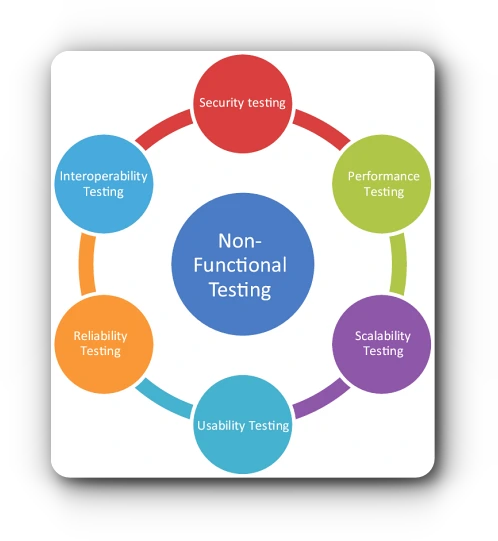In the world of software development, testing plays a vital role in ensuring the quality and reliability of a product. While functional testing focuses on checking if the software meets its specified requirements, non-functional testing looks beyond that, evaluating factors like performance, scalability, security, and usability. In this article, we will explore the various aspects of non-functional testing and its techniques.
What is Functional Testing?
Functional testing is the process of verifying that a software application or system functions as intended. It aims to ensure that all the features and functionalities of the software perform as expected, meeting the defined business requirements. It typically involves checking inputs, outputs, and data manipulation, as well as the interaction between different modules or components.
Functional and Non-Functional Testing Types
Software testing can be divided into two main categories, namely functional testing and non-functional testing. Functional testing, as mentioned earlier, focuses on verifying the functionalities and features of the software. Non-functional testing, on the other hand, aims to assess the quality attributes of the software. Let’s delve deeper into the different types of non-functional testing techniques.
What is Non-Functional Testing?
Non-functional testing is a critical aspect of software testing that focuses on evaluating the performance, usability, reliability, and other non-functional aspects of a software application. Unlike functional testing, which tests the specific functionalities of an application, non-functional testing aims to assess the overall quality and user experience of the software.
Non-functional testing helps identify potential bottlenecks, vulnerabilities, and limitations in a software system, allowing businesses to improve their efficiency and user satisfaction. By simulating real-world scenarios and analyzing the application’s performance under different conditions, non-functional testing provides valuable insights into its overall performance and reliability.
The 7 Non-Functional Test Types Every Tester Should Know
Non-functional testing is as crucial as functional testing in ensuring the overall quality and performance of a software system. While functional testing validates the behaviour of the software, non-functional testing focuses on aspects like performance, reliability, usability, and more. Let’s delve into the 7 key non-functional test types that every tester should be well-acquainted with.
Performance Testing
Performance testing evaluates the responsiveness, stability, and scalability of a software application under various load conditions. It aims to identify performance bottlenecks and ensure the software performs optimally under normal and peak loads.
Load Testing
Load testing is specifically focused on measuring how the system behaves under anticipated user loads. By simulating real-world usage scenarios, load testing helps in determining the system’s ability to handle concurrent user interactions without compromising performance.
Stress Testing
Stress testing pushes the software system beyond its normal operational capacity, aiming to identify the breaking point and understand how the system behaves under extreme conditions. It helps in assessing the system’s robustness and resilience.
Usability Testing
Usability testing is essential for evaluating the user-friendliness and intuitiveness of the software interface. It involves real users performing specific tasks, and the feedback obtained helps in enhancing the overall user experience.
Security Testing
Security testing focuses on identifying vulnerabilities and ensuring the software system’s ability to protect data and maintain the integrity of the system against potential security threats. It includes testing for authentication, authorization, encryption, and more.
Compatibility Testing
Compatibility testing ensures that the software functions seamlessly across different devices, platforms, browsers, and operating systems. It aims to validate that the software delivers a consistent user experience across varied environments.
Compliance Testing
Compliance testing is necessary to ensure that the software complies with industry-specific standards, regulations, and legal requirements. It involves testing for adherence to data privacy laws, accessibility standards, and other relevant regulations.

Non-Functional Testing Tools: Enhancing the Testing Process:
To effectively conduct non-functional testing, organizations can leverage a variety of specialized tools and frameworks designed to streamline the testing process and enhance productivity. These tools offer a range of features, including performance testing, security testing, usability testing, and more.
Performance Testing Tools:
Performance testing tools such as JMeter and LoadRunner enable testers to simulate high user loads and measure the application’s responsiveness, scalability, and stability under stress. These tools help identify performance issues, such as slow response times, memory leaks, or bottlenecks, allowing businesses to optimize their applications for better performance.
Security Testing Tools:
Security testing tools like OWASP ZAP and Nessus help identify vulnerabilities, security loopholes, and weaknesses in the application’s code. These tools ensure that the software is secure from potential threats and adhere to industry-wide security standards.
Usability Testing Tools:
Usability testing tools like UserTesting and Usabilitest aid in evaluating the application’s user-friendliness, intuitiveness, and overall user experience. These tools assess factors such as ease of navigation, clarity of instructions, and visual appeal, resulting in an enhanced user interface and improved customer satisfaction.
Objectives of Non-functional Testing
The primary objectives or goals of performing non-functional testing are outlined below:
- Performance Testing: This testing evaluates the system’s ability to handle expected workloads efficiently and accurately.
- Security Testing: This testing ensures that the system is fortified against unauthorized access, data breaches, and potential vulnerabilities.
- Usability Testing: This testing aims to measure the ease of use, intuitiveness, and overall user-friendliness of the system.
- Compatibility Testing: This testing verifies that the system functions seamlessly across different platforms, devices, and software environments.
- Reliability Testing: This testing assesses the system’s ability to consistently perform its intended functions under various conditions.
- Scalability Testing: This testing examines how well the system can adapt and handle increasing workloads or user demands.
- Maintainability Testing: This testing focuses on evaluating how easily the system can be repaired, modified, or enhanced.
- Availability Testing: This testing ensures that the system remains accessible and operational whenever it is required.
- Compliance Testing: This testing verifies that the system adheres to relevant regulations, standards, and legal requirements.
- Recoverability Testing: This testing evaluates the system’s ability to recover from failures or disasters promptly and with minimal data loss.
How to Manage All Types of Non-Functional Testing
Managing non-functional testing involves a systematic approach to ensure comprehensive coverage of all non-functional aspects. Here are some key steps to effectively manage non-functional testing:
Identify Non-Functional Requirements:
Start by understanding the non-functional requirements of the software application. Consult with stakeholders to determine the desired performance, security, and usability goals and establish clear and measurable criteria.
Design Test Scenarios:
Create test scenarios that reflect real-world usage and represent the intended environment. Consider factors such as user load, system configurations, and network conditions while designing your test scenarios.
Select Appropriate Tools:
Choose the right non-functional testing tools that align with your testing goals and requirements. Consider factors such as budget, ease of use, and relevant features while selecting the tools.
Execute Tests and Analyze Results:
Execute the defined test cases and scenarios using the chosen tools. Monitor the application’s performance, security, and usability metrics and analyze the results to identify any issues or areas of improvement.
Report and Resolve Issues:
Document and report the identified issues, along with recommendations for improvement. Work closely with the development team to resolve the identified issues, ensuring that they are effectively addressed.
Limitations of Non-Functional Testing
While non-functional testing plays a crucial role in ensuring the overall quality and performance of software applications, it does have some limitations. It’s important to be aware of these limitations to implement a comprehensive testing strategy.
Subjectivity:
Evaluating the usability and user experience of an application involves subjective assessments that may vary from user to user. This subjectivity can make it challenging to capture all user expectations and preferences during testing.
Inability to Test in Real Environment:
Non-functional testing is typically conducted in simulated environments, which may not always accurately replicate the actual production environment. This discrepancy can sometimes lead to variations in test results.
Cost and Time Constraints:
Comprehensive non-functional testing can be time-consuming and resource-intensive. Organizations often have budget and time limitations, which may restrict the extent of testing that can be performed.
Despite these limitations, non-functional testing remains a critical component of a robust software testing strategy. By addressing vulnerabilities, enhancing performance, and improving the user experience, it enables businesses to deliver high-quality software applications that meet user expectations and drive customer satisfaction.
In the end, we can say that Non-functional testing is a crucial part of the software development lifecycle that goes beyond mere functionality testing. By assessing performance, security, usability, compatibility, and scalability, non-functional testing helps ensure a robust and reliable software product that meets the expectations of end-users.
By implementing various non-functional testing techniques, organizations can deliver high-quality software applications that function correctly and provide an exceptional user experience.
